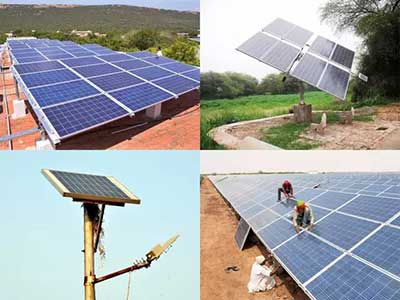Date: 16/12/2022
Relevance: GS-3: Infrastructure: Energy, Ports, Roads, Airports, indigenization of technology and developing new technology.
Key Phrases: India’s Solar Capacity Addition, Rooftop Solar System, Off Grid Solar System, On Grid Solar System, Rooftop Solar, Financing Issues, Power Generation, Grid Tariffs, Off-Grid Projects, Circular Economy Model, Solar Photovoltaic Panel Waste
Context:
- Based on a commitment to address the global climate crisis, India has promised to source nearly half its energy from non-fossil fuel sources by 2030 and, in the shorter term, source at least 60% of its renewable energy from solar power.
- Henceforth, at the core of India’s energy transformation is its bet on solar power although a report has suggested that India faces significant obstacles in this quest.
Key Highlights:
- A key central policy to source solar power is facilitating the establishment of large solar parks since small solar power projects usually translate to higher per-unit production costs.
- Thus, in 2014, the Centre announced the Solar Parks and Ultra-Mega Solar Power Projects Policy to facilitate the creation of large parks.
- The initial plan was to set up 25 parks capable of generating at least 20,000 MW by 2019.
- In 2017, the Government scaled this to 61 parks with a target of 40,000 MW.
- It emerges, however, as of 2022, that only a fourth of the capacity has been achieved, that is, projects worth 10,000 MW have been commissioned.
- Four projects have been cancelled by the Centre due to tardy progress.
Roadblocks in the Commissioning of Solar Projects:
- Challenges in acquiring land with a clear title;
- Setting up the infrastructure necessary to transmit power produced at these parks to the grid;
- Backward integration in the solar value chain is absent as India has no capacity for manufacturing solar wafers and polysilicon.
- Environmental issues in Rajasthan and Gujarat, where projects have been halted because their transmission lines encroach upon the habitat of the critically endangered Great Indian Bustard.
- There have also been conflicts with local communities and biodiversity protection norms.
Is India on track to achieve its renewable energy targets?
- Notwithstanding its claims on international platforms that it is on track to meet renewable energy targets, it is no secret that India is lagging behind.
- By the end of 2022, India had committed to having in place 1,75,000 MW of renewable energy capacity, with 1,00,000 MW from solar power.
- However, only around 61,000 MW of such capacity has actually been installed.
State of India’s Domestic Solar Module Manufacturing Capacity:
- Domestic manufacturing capacities in the solar sector do not match up to the present potential demand for solar power in the country.
- Crisil’s report on the subject highlights that as on March 31, 2021, India had 3 GW capacity for solar cell production and 8 GW for solar panel production capacity.
- Low manufacturing capacities, coupled with cheaper imports from China have rendered Indian products uncompetitive in the domestic market.
Embracing A Circular Economy Model For Solar Systems:
- This would allow solar photovoltaic (PV) panel waste to be recycled and reused in the solar PV supply chain.
- By the end of 2030, India will likely produce nearly 34,600 metric tonnes of solar PV waste.
- The International Renewable Energy Agency (IRENA) estimates that the global value of recoverable materials from solar PV waste could exceed $15 billion.
- Currently, only the European Union has taken decisive steps in managing solar PV waste.
- India could look at developing appropriate guidelines around Extended Producer Responsibility (EPR).
- It means holding manufacturers accountable for the entire life cycle of solar PV products and creating standards for waste recycling.
- This could give domestic manufacturers a competitive edge and go a long way in addressing waste management and supply-side constraints.
Do you know?
- Ground-Mounted Solar Panel System
- Ground-mounted solar panels can be installed in any place on your property that has sufficient open space and good sun exposure.
- The panels can be placed anywhere from a few inches to a few feet off the ground, depending on how the racking system is set up.
- Rooftop Solar (RTS)
- A roof mount is the most common type of installation.
- This is when the solar racking, which holds the panels in place, is installed directly on the roof.
- Panels can be attached to flat or sloping roofs consisting of metal, shingle, or rubber materials.
- Off-Grid Solar PV
- An off-grid PV system refers to an installation that is not connected to the electricity grid.
- This means that all the energy produced is stored and used on-site.
- Essentially, off-grid photovoltaic systems operate from the energy stored in a battery bank.
- On-Grid Solar PV
- An on-grid system is tied to your local utility’s grid. In this instance, whether your solar system under or over-produces, your utility providers’ system will act as battery space.
Conclusion:
- For a few years now, there has been considerable hype around solar power achieving grid parity in India meaning power companies are able to sell it at a price lower or as much as conventional sources — but this does not account for the subsidies or concessions front-loaded by the Government.
- While India should continue to expand its economy on the back of renewable energy, the Government must take a hard look at whether renewable power, solar, wind or nuclear, meets standards of economic viability and environmental sustainability.
- Solar power may be a valuable tool in India’s energy transformation story, but it cannot be the panacea for every need
Source: The Hindu
Mains Question:
Q. How far do you agree that India is on track to achieve its renewable energy targets? Justify your answer. (150 words).



















